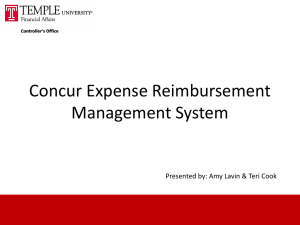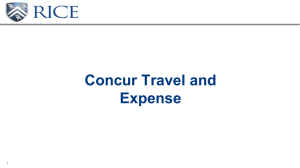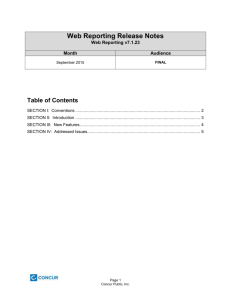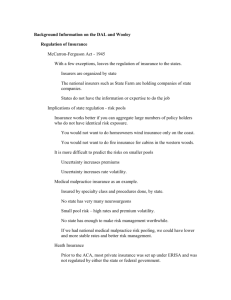Rate Design: Rates for RS and RT
advertisement
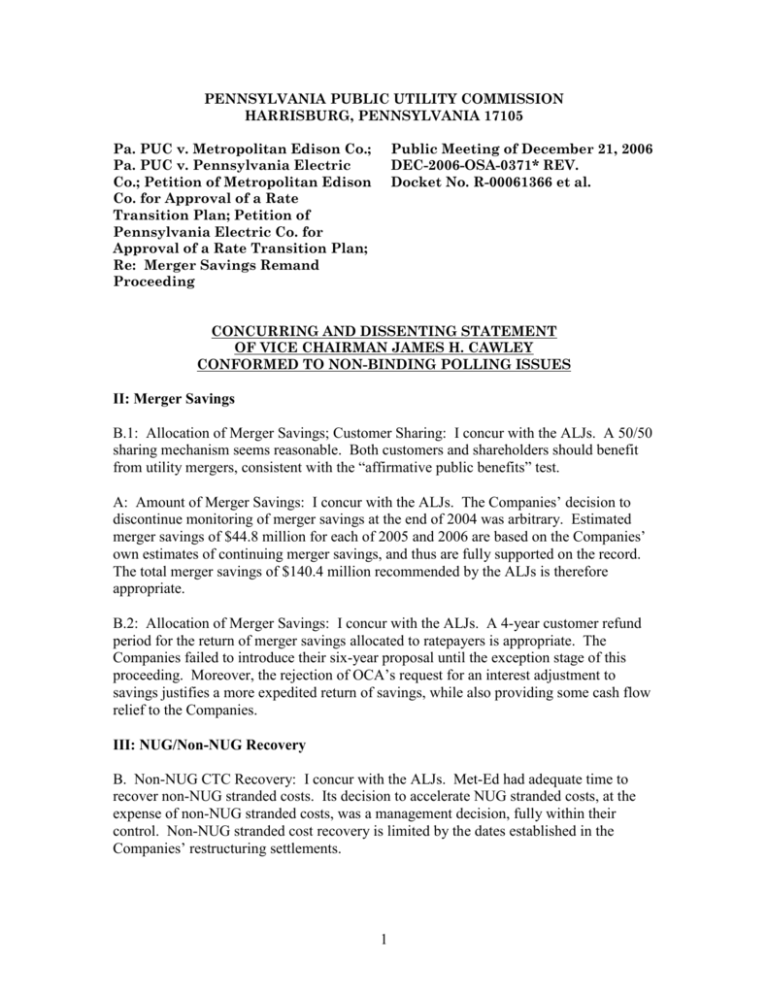
PENNSYLVANIA PUBLIC UTILITY COMMISSION HARRISBURG, PENNSYLVANIA 17105 Pa. PUC v. Metropolitan Edison Co.; Pa. PUC v. Pennsylvania Electric Co.; Petition of Metropolitan Edison Co. for Approval of a Rate Transition Plan; Petition of Pennsylvania Electric Co. for Approval of a Rate Transition Plan; Re: Merger Savings Remand Proceeding Public Meeting of December 21, 2006 DEC-2006-OSA-0371* REV. Docket No. R-00061366 et al. CONCURRING AND DISSENTING STATEMENT OF VICE CHAIRMAN JAMES H. CAWLEY CONFORMED TO NON-BINDING POLLING ISSUES II: Merger Savings B.1: Allocation of Merger Savings; Customer Sharing: I concur with the ALJs. A 50/50 sharing mechanism seems reasonable. Both customers and shareholders should benefit from utility mergers, consistent with the “affirmative public benefits” test. A: Amount of Merger Savings: I concur with the ALJs. The Companies’ decision to discontinue monitoring of merger savings at the end of 2004 was arbitrary. Estimated merger savings of $44.8 million for each of 2005 and 2006 are based on the Companies’ own estimates of continuing merger savings, and thus are fully supported on the record. The total merger savings of $140.4 million recommended by the ALJs is therefore appropriate. B.2: Allocation of Merger Savings: I concur with the ALJs. A 4-year customer refund period for the return of merger savings allocated to ratepayers is appropriate. The Companies failed to introduce their six-year proposal until the exception stage of this proceeding. Moreover, the rejection of OCA’s request for an interest adjustment to savings justifies a more expedited return of savings, while also providing some cash flow relief to the Companies. III: NUG/Non-NUG Recovery B. Non-NUG CTC Recovery: I concur with the ALJs. Met-Ed had adequate time to recover non-NUG stranded costs. Its decision to accelerate NUG stranded costs, at the expense of non-NUG stranded costs, was a management decision, fully within their control. Non-NUG stranded cost recovery is limited by the dates established in the Companies’ restructuring settlements. 1 C: NUG Cost Recovery: I concur with the ALJs. The Companies’ proposal to change the accounting for and recovery of NUG costs is in contravention of the restructuring settlement. IV: Generation Rate Caps 1: 1998 Restructuring Plan: I concur with the ALJs. The Companies were not required to sell their generation assets and could have better hedged their exposure to rising energy costs. Therefore, exceptions in § 2804(4) do not apply with regard to generation costs as defined by the Companies in this proceeding. 2: FE Assumption of POLR obligation: I concur with the ALJs. First Energy should have understood its obligations when it purchased the Companies. 3: POLR Procurement Strategy: I concur with the ALJs. Same logic as in section IV-1 above. 4: Fiduciary Obligation: I concur with PPL. The argument that the Companies have an obligation to their shareholders is irrelevant to the proper determination of the Companies’ requests for a generation rate increase. What is relevant is that Met-Ed and Penelec had a responsibility to take appropriate management steps to live up to their obligations under the Restructuring Settlement. 5: Relationship to Other EDCs: I concur with MEIUG/PICA. The ALJs correctly determined that the differences the Companies allege (between divesting and nondivesting utilities) are of no importance or relevance and must be dismissed. V. Transmission Service Charge Rider 1. Inclusion of Rider: I concur with the ALJs. This type of mechanism is similar to that approved by the Commission for PPL. PPL’s TSC is audited to ensure compliance with the TSC Rider. As noted by the Companies, § 1307(e) mandates a public hearing on the annual reconciliation report, as well as “any matters” pertaining to the TSC. 2. Congestion Costs: I concur with MEIUG/PICA, Constellation, and OCA. DISSENTING STATEMENT I concur with the arguments of the consumer groups on this issue. Congestion costs arise because of differences in generation costs across the transmission grid. While it is true that transmission constraints are a necessary condition for congestion costs, it is the actual generation prices, in the form of location marginal price (“LMP”), which forms the basis for congestion-related charges. This fact was well articulated by the arguments of MEIUG/PICA and Constellation. Moreover, company management has discretion to either purchase generation near a company’s electric load and incur little if any congestion costs, or to purchase electricity from very distant sources and incur substantial 2 congestion costs. Further, reliance on the mere fact that such charges are in the PJM OATT is, in my opinion, irrelevant. Imbalance energy charges and capacity costs are also in the OATT, yet these charges are clearly generation related. Imbalance energy charges are also based on LMP, which form the basis for congestion charges. With regard to the functionalization of this cost element as generation or transmission, I find it particularly compelling that a party to this proceeding (Constellation) that would likely benefit from an increase in the overall shopping credit, which includes transmission costs, would take exception to the Companies’ position on this issue. Finally, I recognize that this Commission has previously approved a TSC for PPL, but that TSC does not include congestion-related charges. By approving the inclusion of congestion-related costs into the TSC, we are creating a potentially perverse incentive for the Companies to minimize their purchase costs for energy from generators, while maximizing their congestion costs, with the effect that consumers will not get the benefit of the bargain—capped rates—from the restructuring settlement. In fact, it is likely that overall supply costs will no longer be fixed for the remainder of the generation cap period, but will fluctuate from year-to-year. Moreover, inclusion of congestion costs in a TSR may open Pandora’s box for other utilities to, in effect, break the rate caps that they have honored to date, since all utilities will have the right to seek transmission rate increases effective January 1, 2007. In short, I am sympathetic to providing the Companies with some relief for current congestion costs, but I am not disposed to doing this through a TSC mechanism. My concern is that a decision to include such costs in the transmission charge may be the easy decision, but not the right decision going forward. 3. Deferred [Transmission] Costs DISSENTING STATEMENT I concur with the arguments of MEIUG/PICA, OSBA, and OCA. As MEIUG/PICA pointed out, transmission costs could have been anticipated or reasonably forecasted, particularly with regard to Network Transmission Service (“NITS”) and ancillary costs that currently exceeds the costs recoverable under rates approved in the restructuring proceeding. Secondly, NITS and ancillaries are not extraordinary costs. Lastly, the transmission rates expired at the end of 2004, and the Companies could have filed for an increase in early 2004. MEIUG/PICA is correct that the Companies’ transmission rate caps expired on December 31, 2004. According to the Companies’ own testimony, transmission costs increased steadily, not abruptly, each year from 2003 through 2006. Like PPL, the Companies could well have filed for a TSC in 2004, effective in 2005 or 2006. For these reasons, the Companies, in my opinion, failed to meet the three-pronged analysis for assessing recovery of deferred costs as established by the Commonwealth Court in Popowsky v. Pa. Public Utility Commission, 868 A.2d 606 (Pa. Cmwlth. 2004). 3 4. Carrying Charges on Deferred Costs: As noted, I oppose deferral of any 2006 transmission costs. However, if this deferral of transmission costs met the three-pronged analysis for assessing recovery of deferred costs as established by the Commonwealth Court in Popowsky v. Pa. Public Utility Commission, 868 A.2d 606 (Pa. Cmwlth. 2004), I would concur with the ALJs on this matter and include carrying charges on appropriately deferred transmission costs. 5. Bypassable amortization of deferred costs: I vote to deny OSBA’s exception. As a general rule, an EGS incurs its own transmission costs when serving a customer. Transmission costs related to utility default service should not be imposed on customers receiving supply service from an EGS. VII. Rate Base/Cash Working Capital A.1: Distribution: Pa. Corporate net income tax and Pa. capital stock tax: I concur with the ALJs. Testimony demonstrated that the Companies use the “Safe Harbor” method of tax payment. Furthermore, OTS failed to demonstrate that the “statutory” method of payment was the standard methodology this Commission has used historically. A.2: Distribution: Treatment of “non-cash” items: I concur with the ALJs. OCA clearly demonstrated that non-cash items should be excluded from the Companies’ cash working capital, consistent with historical practice by this Commission. A.3: Distribution: Treatment of transmission costs: I concur with the ALJs. These two transactions, one related to FERC-related wholesale transmission service, and the other related to retail transmission service, appear to be mutually exclusive. A.4: Distribution: Treatment of return on equity and payment lag associated with interest on long-term debt: I concur with the ALJs. OCA demonstrated that return on equity should be excluded from the cash working capital calculations, and that interest should be included with a payment lag reflecting the terms of the debt, consistent with historical practice by this Commission. VIII. Revenues and Expenses E. Pension Expense: I concur with the Companies. I agree that the Commission should endeavor to recognize normalized contributions to the Pension Fund. If these base rates remain in place for more than one year, the Companies potentially may not receive adequate compensation for these pension fund contributions. The record establishes that these contributions are “lumpy”. I therefore concur with the Companies alternative normalization methodology. H. Consolidated Tax Savings: I concur with the ALJs. Under the “actual taxes paid” doctrine, enunciated by the Pennsylvania Supreme Court in Barasch v. Pa. Public Utility Commission, 507 Pa. 496, 491 A.2d 94 (1985), the practice of setting rates on a utility’s 4 stand-alone tax expense was rejected. While I may not agree personally with this decision, I am compelled to follow it. J. Decommissioning Costs: I concur with the ALJs. I agree that it is important to adequately fund nuclear decommissioning costs, and I find the Company’s revised estimates reasonable. I. Conservation and Renewables Initiatives. I concur with Citizens Power, the Berks County Community Foundation, and the Community Foundation for the Alleghenies to the extent that they advocate for continued funding of these Sustainable Development Funds at the level of 0.01 cents per kWh starting January 1, 2008. I believe these parties have established a reasonable record for the continuation of this renewable program funding mechanism. Starting January 1, 2011, EGSs and EDCs serving customers in this service area will be subject to the AEPS requirements. These Funds should help establish technologies that will help drive down compliance costs in the long term. Consistent with the need to encourage development of renewable energy, the Funds should consult with the Pa. Sustainable Energy Board to establish priorities for the use of these funds. That Board should review project selections on an annual basis to ensure that they are consistent with the established priorities. The Funds should minimize the amount used to support personnel and administrative costs and should report to the Board on an annual basis on how they are achieving this objective. IX. Rate of Return: A. Capital Structure: I concur with the ALJs. I agree that the proposed 51% long-term debt and 49% common equity capital structure is appropriate. Further, I concur that the First Energy debt should not be included in the cost of debt for the Companies. B. Cost of Capital: I concur with the ALJs. The ALJs properly did not rely on the First Energy acquisition debt, but instead relied on the cost of the Companies’ debt in establishing this cost of capital. C. Return on Equity: I concur with the ALJs who properly relied on the DCF analysis, and properly recommended the low-end return resulting from the DCF analysis to reflect the ongoing service quality problems that affect the Companies’ ratepayers. X. Cost of Service: 1. Distribution Rate and Revenue Change: The ALJs allocated transmission costs on a demand/energy basis and recommended a uniform kWh charge for each customer rate schedule. This approach should result in proper transmission cost allocation to the various rate classes, and simultaneously simplify future retail choice decisions for consumers once rate caps are lifted. 2. Interpretation of Lloyd v. Pa. PUC: The ALJs correctly concluded that the proper interpretation of Lloyd is that a COSS is the primary, but not the only, basis for cost allocation for each unbundled element. 5 XI: Rate Design C.1: Disputed Rate Design Issues - Rates for RS and RT DISSENTING STATEMENT With regard to the increase in customer charges, I concur with the position of OCA. The ALJs support the Companies on the basis that any fixed customer charge should cover those associated with meters, meter reading, billing and collection costs, etc. In fact, OCA and the Companies largely agree with this concept. While this does sound reasonable, an examination of the evidence submitted in this case clearly shows that the Companies included much more than just these costs when deriving their higher customer charge. Based on the evidence submitted by Edward Stein (Statement No. 5, Unbundled Cost of Service Study, Exhibit EBS-2, Section 1), the Companies include substantial distribution plant (predominantly transformer costs) and cash working capital, while including substantial A&G costs, outside services and miscellaneous items, which the Companies fail to fully describe in their testimony as customer related. Based on these facts, I believe the Companies have failed their burden of proof to justify an increase in fixed customer charges. With regard to removal of Time of Day (“TOD”) and seasonal rates for the RT rate schedule, I again concur with the position of OCA. The Companies’ own testimony acknowledges that distribution demand related costs are allocated via voltage peak responsibility, and the method entails finding the coincidental peak demand. Given that coincidental peak demand is largely seasonal in nature, and TOD-related, I disagree that distribution costs have no relation to TOD or seasonal influences. While I also acknowledge the Companies’ testimony that, as one moves down the delivery system from bulk transmission to delivery of energy to a customer location, load becomes less diverse. However, the Companies fail to provide evidence that this less diverse loading justifies removing all coincidental peak influences. In fact, I am unable to find any evidence by the Companies to quantify diversity of load effects on the distribution system. I therefore agree with OCA that the Companies have failed their burden of proof to eliminate entirely TOD and seasonal pricing from distribution rates. C. Disputed Rate Design Issues: Rates GS and GST: I concur with the ALJs. XII. Tariff Provisions D.1: Disputed Tariff Issues – Real Time Pricing (RTP). I concur with the ALJs in result only. In light of capped generation rates, this provision is premature and unlikely to result in substantial customer participation at this time. Moreover, this issue is more appropriately addressed in the POLR proceeding. To the extent that a large customer currently wants a RTP supply service, it can likely obtain this product from an EGS right now. 6 D.2: Disputed Tariff Issues – Wind Product: I concur with the ALJs. It would be inappropriate to develop a wind product at this time absent more details. As the Companies noted, Met-Ed and Penelec have not been provided with any information on the cost of implementing such a product or how much customers would have to pay for such a product in order for Met-Ed and Penelec to fully recover those costs. D.3: Disputed Tariff Issues – Hourly Pricing. I concur with the ALJs. As noted, this issue is premature and should be addressed in the generic POLR proceedings. D.4: Disputed Tariff Issues – Seasonal Time of Day Provisions: I concur with MEIUG/PICA. I believe the Company failed to carry its burden of proof that all seasonality should be removed from distribution rates for the reasons stated previously. Secondly, this Commission has historically given deference to maintaining rate design stability during the rate cap period to avoid improper cost shifting. In principle, I agree with Met-Ed’s revisions to cost allocation in generation rates. However, I find this premature at this time. This should be taken up at the end of the capped rate period. D.5: Disputed Tariff Issues – Elkland Rates: I concur with the ALJs, assuming that Penelec’s clarifications are adopted. Penelec clarified that it will file annual changes to its retail tariff to reduce rates for non-Elkland customers by the amount of the change in the discount applicable to Elkland customers. In this way, there is no “windfall” and no under-recovery associated with the annual Elkland changes. XIII. Section 1307 Riders B. Universal Service Cost Rider: I concur with the ALJs who correctly approved the use of the USCR to recover universal service costs. Further, the ALJs correctly limited recovery of the USCR to residential customers. These recommendations are consistent with the Commission’s Order on Customer Assistance Programs: Funding Levels and Cost Recovery Mechanisms, Docket No. M-00051923, entered December 18, 2006. Regarding whether the USCR should be a line item on the bill, I disagree with the ALJs. The USCR should not be a separate line item on residential customer bills. XV. Directed Question of Vice Chairman Cawley OTS exception should be granted. OTS excepted to the ALJs’ lack of recognition of its comments on the Directed Questions. I agree that the OTS did file comments on these directed questions and thank them for their contributions to the record. XVIII. Order – Tariff Supplements OSBA’s exceptions should be granted, and the Companies should be directed to file tariffs that produce a specified total amount of revenues for generation, transmission, distribution and universal services, and stranded costs as directed in this proceeding. 7 XVIII. Order – Redlining Issues OSBA’s exceptions should be granted, and the Companies should be directed to present their compliance tariffs with redlines in order to identify the changes from presently approved tariffs. I would also encourage all utilities to submit redlined tariffs for all tariff changes going forward. XIX. Miscellaneous Misc. - Collaborative Working Group A collaborative working group is appropriate. However, such a collaborative has already been established to address these issues at the statewide level with regard to solicitation documents. Therefore, I concur with the Companies that Constellation’s exceptions should be denied. If Constellation finds it appropriate to accelerate these discussions, it should present these suggestions to the working group. Misc. – Education Education is a very important element as customers migrate to current market prices in 2011. It is anticipated that we will address educational issues within the context of our price mitigation proceeding on a statewide level. Therefore, Constellation’s exception should be denied. Misc. – Default Service [POLR] Administrative Costs This Commission must clearly articulate and develop its policy or regulations on inclusion of administrative costs associated with default service. However, it is more appropriate to address this issue within the context of the default service regulations. Therefore, I concur with OSBA on this matter. December 21, 2006 _____________________________ James H. Cawley Vice Chairman 8
